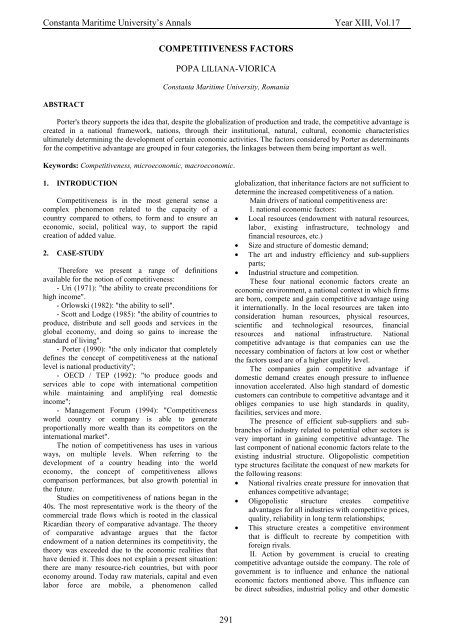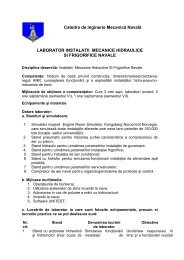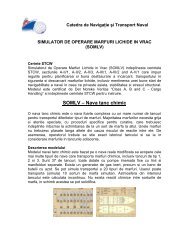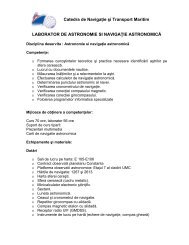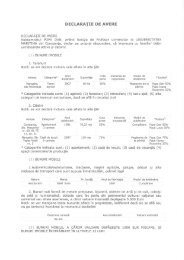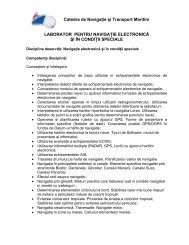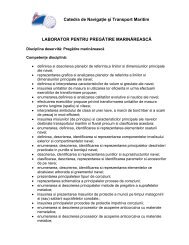Constanta Maritime University's Annals Year XIII, Vol.17 291 ...
Constanta Maritime University's Annals Year XIII, Vol.17 291 ...
Constanta Maritime University's Annals Year XIII, Vol.17 291 ...
You also want an ePaper? Increase the reach of your titles
YUMPU automatically turns print PDFs into web optimized ePapers that Google loves.
<strong>Constanta</strong> <strong>Maritime</strong> University’s <strong>Annals</strong> <strong>Year</strong> <strong>XIII</strong>, <strong>Vol.17</strong><br />
ABSTRACT<br />
COMPETITIVENESS FACTORS<br />
POPA LILIANA-VIORICA<br />
<strong>Constanta</strong> <strong>Maritime</strong> University, Romania<br />
Porter's theory supports the idea that, despite the globalization of production and trade, the competitive advantage is<br />
created in a national framework, nations, through their institutional, natural, cultural, economic characteristics<br />
ultimately determining the development of certain economic activities. The factors considered by Porter as determinants<br />
for the competitive advantage are grouped in four categories, the linkages between them being important as well.<br />
Keywords: Competitiveness, microeconomic, macroeconomic.<br />
1. INTRODUCTION<br />
Competitiveness is in the most general sense a<br />
complex phenomenon related to the capacity of a<br />
country compared to others, to form and to ensure an<br />
economic, social, political way, to support the rapid<br />
creation of added value.<br />
2. CASE-STUDY<br />
Therefore we present a range of definitions<br />
available for the notion of competitiveness:<br />
- Uri (1971): "the ability to create preconditions for<br />
high income".<br />
- Orlowski (1982): "the ability to sell".<br />
- Scott and Lodge (1985): "the ability of countries to<br />
produce, distribute and sell goods and services in the<br />
global economy, and doing so gains to increase the<br />
standard of living".<br />
- Porter (1990): "the only indicator that completely<br />
defines the concept of competitiveness at the national<br />
level is national productivity";<br />
- OECD / TEP (1992): "to produce goods and<br />
services able to cope with international competition<br />
while maintaining and amplifying real domestic<br />
income";<br />
- Management Forum (1994): "Competitiveness<br />
world country or company is able to generate<br />
proportionally more wealth than its competitors on the<br />
international market".<br />
The notion of competitiveness has uses in various<br />
ways, on multiple levels. When referring to the<br />
development of a country heading into the world<br />
economy, the concept of competitiveness allows<br />
comparison performances, but also growth potential in<br />
the future.<br />
Studies on competitiveness of nations began in the<br />
40s. The most representative work is the theory of the<br />
commercial trade flows which is rooted in the classical<br />
Ricardian theory of comparative advantage. The theory<br />
of comparative advantage argues that the factor<br />
endowment of a nation determines its competitivity, the<br />
theory was exceeded due to the economic realities that<br />
have denied it. This does not explain a present situation:<br />
there are many resource-rich countries, but with poor<br />
economy around. Today raw materials, capital and even<br />
labor force are mobile, a phenomenon called<br />
<strong>291</strong><br />
globalization, that inheritance factors are not sufficient to<br />
determine the increased competitiveness of a nation.<br />
Main drivers of national competitiveness are:<br />
I. national economic factors:<br />
• Local resources (endowment with natural resources,<br />
labor, existing infrastructure, technology and<br />
financial resources, etc.)<br />
• Size and structure of domestic demand;<br />
• The art and industry efficiency and sub-suppliers<br />
parts;<br />
• Industrial structure and competition.<br />
These four national economic factors create an<br />
economic environment, a national context in which firms<br />
are born, compete and gain competitive advantage using<br />
it internationally. In the local resources are taken into<br />
consideration human resources, physical resources,<br />
scientific and technological resources, financial<br />
resources and national infrastructure. National<br />
competitive advantage is that companies can use the<br />
necessary combination of factors at low cost or whether<br />
the factors used are of a higher quality level.<br />
The companies gain competitive advantage if<br />
domestic demand creates enough pressure to influence<br />
innovation accelerated. Also high standard of domestic<br />
customers can contribute to competitive advantage and it<br />
obliges companies to use high standards in quality,<br />
facilities, services and more.<br />
The presence of efficient sub-suppliers and subbranches<br />
of industry related to potential other sectors is<br />
very important in gaining competitive advantage. The<br />
last component of national economic factors relate to the<br />
existing industrial structure. Oligopolistic competition<br />
type structures facilitate the conquest of new markets for<br />
the following reasons:<br />
• National rivalries create pressure for innovation that<br />
enhances competitive advantage;<br />
• Oligopolistic structure creates competitive<br />
advantages for all industries with competitive prices,<br />
quality, reliability in long term relationships;<br />
• This structure creates a competitive environment<br />
that is difficult to recreate by competition with<br />
foreign rivals.<br />
II. Action by government is crucial to creating<br />
competitive advantage outside the company. The role of<br />
government is to influence and enhance the national<br />
economic factors mentioned above. This influence can<br />
be direct subsidies, industrial policy and other domestic
<strong>Constanta</strong> <strong>Maritime</strong> University’s <strong>Annals</strong> <strong>Year</strong> <strong>XIII</strong>, <strong>Vol.17</strong><br />
demand indirectly by shaping the standards and<br />
regulations. A crucial role of the government market is<br />
the fact that is a major buyer of goods and technologies<br />
such as telecommunications equipment, weaponry,<br />
computers, vehicles etc..<br />
III. Mondo-economic factors are constituted of<br />
three main elements:<br />
• Deregulation of the U.S. had four important<br />
consequences:<br />
• eradication of strong inflation (inflation down below<br />
4%);<br />
• loss of state control over interest rates and exchange<br />
rate term by strengthening financial markets;<br />
• directing the market economy at the expense of<br />
government;<br />
• Consolidation involves globalization economies to<br />
cope with increased competition.<br />
• Collapse of communist systems of economic<br />
management - a phenomenon with many economic<br />
and political implications.<br />
-Internet explosion - as soon the whole world will<br />
be "a global network" and everyone can receive and<br />
deliver messages for any purpose including buying or<br />
selling.<br />
Globalization of markets has led globalization<br />
marketing. Global marketing refers to encouraging<br />
research initiatives to find new market segments or<br />
niches around the globe, harnessing the opportunity of<br />
buying and selling products and services internationally.<br />
Globalization of markets has triggered a<br />
phenomenon that at first sight seems paradoxical to say<br />
individualization consumer needs. Gradually the<br />
company's trade policy is going from national markets to<br />
absorption of the transnational consumer segmentation<br />
with identical behaviour in several countries. Productmarket<br />
couple move from a national even international<br />
European dimension.<br />
The production is not standardized, but flexible and<br />
the company is no longer considered an isolated entity, it<br />
maintains itself with suppliers, distributors a set of<br />
relationships which give a high degree of flexibility in<br />
operation.<br />
IV. Other factors affecting competitiveness are:<br />
• Structure favouring foreign investment and domestic<br />
demand helps to modernize the economy. The most<br />
widespread foreign investment may have adverse<br />
effects located mainly in the industrial specialization<br />
(in many areas indigenous firms are unable to<br />
defend their market positions in the foreign<br />
companies).<br />
• Demands ever higher that environmental protection<br />
requires.<br />
• Evolution phenomena and processes in the global<br />
economy.<br />
According to Michael Porter, the main factor of<br />
profitability of firms is given by the industrial sector for<br />
economic attractiveness. In any industry, there are five<br />
forces that determine the profitability and structure: the<br />
entry of new competitors, the existence of substitutes,<br />
bargaining power of buyers, bargaining power of<br />
producers and economic rivalry. The importance of the<br />
five forces varies from one industry to another<br />
292<br />
depending on economic and technical characteristics<br />
change over time (M. Porter, 1980).<br />
Michael Porter distinguishes three types of<br />
strategies that can be applied by companies to create<br />
competitive advantage: cost leadership through<br />
differentiation and focus. Appropriate strategy allows the<br />
company to capitalize on strengths and to protect the<br />
adverse effects of the five forces. Each of the three<br />
strategies involves choosing different ways to ensure<br />
competitive advantage.<br />
Porter defines four stages of competitive development at<br />
national level:<br />
• The development stage due to factors of production;<br />
• Develop specific investment stage;<br />
• The development stage due to innovation;<br />
• Stage of development determined by wealth.<br />
3. RESULTS AND DISCUSSION<br />
The transition from one stage to another involves a<br />
metamorphosis in the industrial infrastructure, financial<br />
system, technological standards and attitudes. A great<br />
importance id also constituted by cultural values behind<br />
the forces creating and distributing wealth. To explain<br />
the success of similar systems adopted by different<br />
countries is necessary deep understanding of cultural<br />
ethics and social values of these nations.<br />
The first three stages of economic development,<br />
national competitiveness is increasing, and in the fourth<br />
economy may decline. Following the four stages of<br />
developing the competitiveness of a nation defined by<br />
Porter, Romania could be between the first and second<br />
stage, and between that determined by factors that<br />
determine production and investment. The<br />
competitiveness notion has various uses in multiple<br />
ways. The term is used in national competitiveness, but<br />
sequentially, for narrow areas such as international trade,<br />
commodity market and others.<br />
4. CONCLUSIONS<br />
To obtain an advantageous position on the reference<br />
market, the companies are determined to discover the<br />
factors of competitiveness that will put in such a position<br />
and will enable competitive advantage. Moreover, a<br />
trader with a marketing vision focuses its strategy<br />
towards the market in order to create a product or a<br />
service more competitive, that the consumer needs and is<br />
adapted to the exigencies.<br />
The most important factors that may contribute<br />
decisively to the competitiveness of an organization, are<br />
considered next:<br />
- price of the product / service. If a product or service<br />
satisfies a consumer need, be it especially if price is<br />
lower than that of competitors. As a result, price<br />
competition becomes a factor eliminator.<br />
- quality product / service. If the product or service to<br />
consumers the same price is better quality than the<br />
competitors, then be preferred by consumers, quality<br />
becomes a factor eliminator.<br />
- value for money. This factor captures the best way to<br />
purchase a product or service to most consumers, while<br />
highlighting the competitiveness of enterprises. If at a
<strong>Constanta</strong> <strong>Maritime</strong> University’s <strong>Annals</strong> <strong>Year</strong> <strong>XIII</strong>, <strong>Vol.17</strong><br />
certain quality of a product or service required a higher<br />
price than the prevailing market respect, the value for<br />
money becomes a factor eliminator for the entity in<br />
question, because it fails to obtain profit than by<br />
increasing the price of a product (service) the same<br />
quality to that provided by its direct competitors. Or the<br />
selling price is the same with that of competitors, but<br />
quality product (service) is lower.<br />
Using these three factors determining<br />
competitiveness quantitative always a balancing market<br />
as a price reduction or quality improvement of products /<br />
services will determine the reaction the other<br />
competitors, so that consumers will be permanently put<br />
in the position to choose the product or service with the<br />
best quality / price ratio.<br />
- cost of the product / service. To be efficient and<br />
competitive businesses are looking to produce a lower<br />
cost as consumer products or services.<br />
- profit. The difference between price and cost of<br />
production becomes the profit gained through work<br />
performed by the entity. Profit, the competitive factor is<br />
both a function and objective pursued by it.<br />
- the cost / profit. Even if profit maximization is the goal<br />
of any trader, this does not allow obtaining competitive<br />
if profit is made with high costs. In the long run, the<br />
operator be removed from the market by a competitor<br />
who registers the same income but with a cost / profit<br />
efficiency. There are situations, especially for small<br />
businesses, when a company can ACTi a small market<br />
and a profit based on production costs very low. in time,<br />
the lack of possibility to allocate a portion of profit for<br />
development, investment, etc., is precisely its lack of<br />
competitiveness will lead to removal from the market.<br />
- volume of sales made. This factor determines the size<br />
of the economic competitiveness in the market<br />
concerned, especially when they can be calculated and a<br />
series of indicators of capacity market (market share,<br />
relative market share). As the market share held by a<br />
company be greater, the more we can say that it occupies<br />
much of the market, so it holds a competitive position.<br />
- economies of scale. The quality factor contributes<br />
significantly to the competitiveness of an economic<br />
agent. As it achieve a higher yield lower cost experience<br />
curve occur that cause economies of scale.<br />
- technology used. May become an important asset of an<br />
undertaking which uses modern production capacity, has<br />
a high capacity to integrate Cloudy and technological<br />
progress in a particular field.<br />
- time. As the decisive factor to obtain competitive<br />
advantage time is the speed of providing a product /<br />
service, but also the reaction speed of competitors in<br />
certain situations. To these we can add the speed "with<br />
which consumers can choose the product / service,<br />
providing a great source of variety information sources.<br />
- management. It is a decisive competitive factor<br />
especially when used by managers who fail to harmonize<br />
their objectives with available resources and market<br />
demands. In other words the entire management system<br />
should be market oriented, so that now manage to hold a<br />
competitive position. But this can not be achieved<br />
without applying the next competitive edge:<br />
- marketing. Regarded as a function of enterprise<br />
marketing is one of the most significant competitive<br />
293<br />
factors existing at present. As consumers are turning to<br />
these products / services that best meet their needs, they<br />
will choose those who have significant advantages. As<br />
stated Philip Kotler.<br />
Most prosperous companies are those that manage<br />
to offer their customers the expected satisfaction,<br />
understanding marketing cape not a separate function but<br />
as the learned philosophy of the entire organization.<br />
What is needed is to identify marketing compartment<br />
categories of consumers and the needs that a company<br />
can meet in a profitable way, and the ways in which this<br />
can be achieved with high efficiency in comparison with<br />
other competitors.<br />
The first stages of economic development, national<br />
competitiveness is increasing, and in the fourth economy<br />
may decline. Following the four stages of developing the<br />
competitiveness of a nation defined by Porter, Romania<br />
could be between the first and second stage, and between<br />
that determined by factors that determine production and<br />
investment. The competitiveness notion has various uses<br />
in multiple ways. The term is used in national<br />
competitiveness, but sequentially, for narrow areas such<br />
as international trade, commodity market and others.<br />
If we consider equality between prosperity and<br />
competitiveness, then rightly marketing vision, so<br />
necessary a company acting in a competitive market,<br />
requires that it be market oriented, taking into account<br />
customers, and competitors.<br />
It is possible that in the future to shape a new factor<br />
of competitiveness, management, marketing, because it<br />
embodies the best all processes, relationships and<br />
practical actions necessary to carry out an effective<br />
activities designed to ensure a position in a competitive<br />
field. Understood and used effectively, marketing<br />
management can be turned into an advantage major<br />
competitiveness of enterprises (organizations) modern<br />
market oriented.<br />
The level that is generated is the microeconomic<br />
competitiveness. A country becomes competitive when<br />
you manage to build that environment that allows each<br />
company to become effective added value, to be able to<br />
survive or develop in any domestic economic<br />
environment, especially internationally.<br />
The level that supports and reinforces<br />
competitiveness is macroeconomic. Country maintains<br />
or improves their profitability internationally when<br />
deciding to apply the set of economic policies to<br />
stimulate the achieving optimal micro-level required<br />
expansion.<br />
5. REFERENCES<br />
[1] CIUPEGEA, C. A summary of the concept of<br />
competitiveness, the National Institute of Economic<br />
Research <strong>Annals</strong>, Romanian Academy, INCE, CIDE,<br />
Bucharest, 2001;<br />
[2] IANCU, A., Advantage theories, industrial and<br />
development of European integration, Economica, no. 3-<br />
4/2000, SOREC, IRLI, Bucharest, 2000;<br />
[3] HORNIANSCHI, N., Selective restructuring of<br />
industrial production - macro and micro component of<br />
the strategy, PhD Thesis, National Institute of Economic<br />
Research, Bucharest, 1998.
<strong>Constanta</strong> <strong>Maritime</strong> University’s <strong>Annals</strong> <strong>Year</strong> <strong>XIII</strong>, <strong>Vol.17</strong><br />
[4] AXELROD, R., The evolution of cooperation,<br />
Ed.Basic Books, 2004.<br />
294<br />
[5] PORTER, M., FULLER, M., Coalitions and global<br />
strategy in Porter M.E. (ed), Competition in global<br />
industry, Harvard University Press, 2006.


